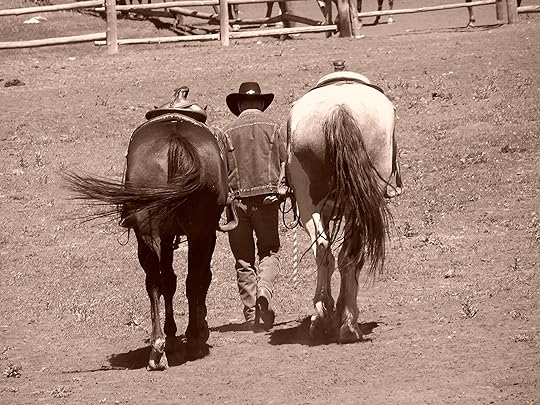Andrea Downing's Blog, page 15
August 26, 2013
Why I Ride by Amy Hale Auker
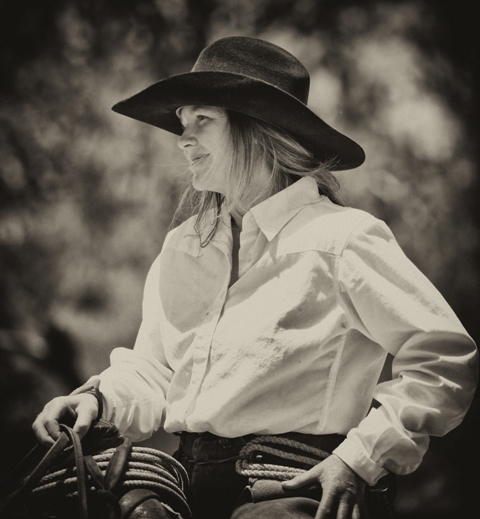
Amy Hale Auker
Fellow member of Women Writing the West, Amy Hale Auker, is a Texan now living in Arizona, a writer, mother, and cowboy.She writes and rides in the Santa Maria Mountains with her husband, singer/songwriter Gail Steiger. Her first book, Rightful Place, was the 2011 WILLA winner for creative non-fiction and Foreword Book Reviews’ Book of the Year for essays. Winter of Beauty 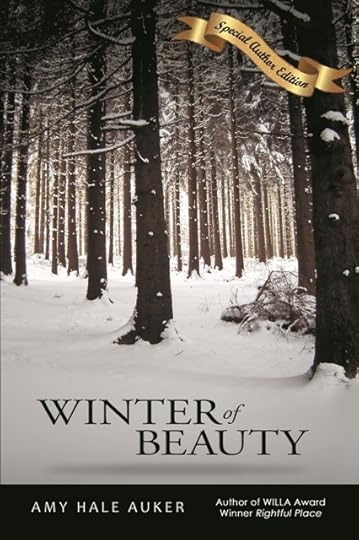 is her first novel and will be officially released by Pen-L Publishing in October. Until then, the Special Author Edition is available only from Amy’s website.
is her first novel and will be officially released by Pen-L Publishing in October. Until then, the Special Author Edition is available only from Amy’s website.
Why I Ride
I love my work. I love to work. Not work out, with mindless, meaningless repetitions, but to do work that results in something of value. I like sweat and weather and eating only when I am hungry. I like how horses smell 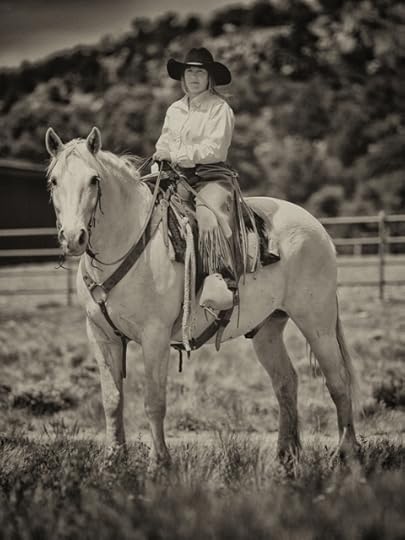 and how cows sound. I love lying down at night, truly tired, deep down in my bones, but fresh in my soul. I like cooking out of doors and sleeping without walls. All of this is a good thing because one of my main jobs is to help manage a herd of mother cows who are harvesting the things that grow out of the ground in our national forests. These cows live their whole lives out in the forest, eating and napping, gestating and lactating. Our job is to rotate them from pasture to pasture so that they have as little impact as possible while they are harvesting the grasses and forbs and browse. We harvest their increase, keeping a few heifers every year and selling the steers as beef.
and how cows sound. I love lying down at night, truly tired, deep down in my bones, but fresh in my soul. I like cooking out of doors and sleeping without walls. All of this is a good thing because one of my main jobs is to help manage a herd of mother cows who are harvesting the things that grow out of the ground in our national forests. These cows live their whole lives out in the forest, eating and napping, gestating and lactating. Our job is to rotate them from pasture to pasture so that they have as little impact as possible while they are harvesting the grasses and forbs and browse. We harvest their increase, keeping a few heifers every year and selling the steers as beef.
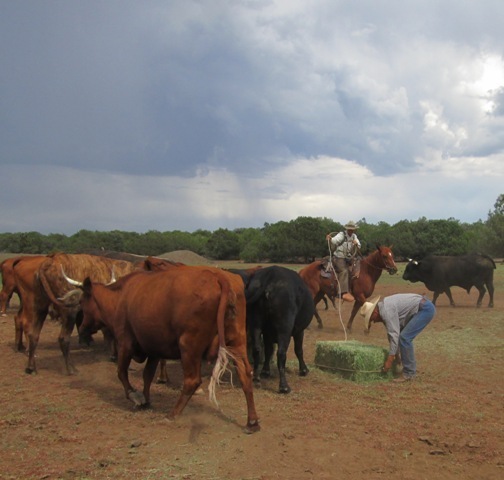
Feeding before the Storm
And so, when it is time to make a move, I ride. I ride for long hours in the weather. And I learn to see the tracks in the dirt so I know if there are any cows in this part of the country or not. I learn to honor a cow’s ability to get around in the brush and the rocks. And I carry a pen and paper with me always…
My riding and my work as a cowboy feed my other work, my lifework. Because I ride, I never lack material to write about. I have a wealth of experiences and details to bring to the page. And unlike other writers, I do not bemoan my lack of time to write because every moment that I am in the saddle, I am writing in my mind.
About the time my body is exhausted and I am sick of eating canned chili, the cows are moved and it is time to go back to my office. About the time the walls of my office close in and I am am sick of facebook, it is time to ride again. Or time to get ready to ride. Shoe up all of the horses. Examine each set of camp boxes and make lists to supply them for the long haul. Toilet paper, coffee, ibuprophen, canned peaches, Spam. Yes, Spam. Ride all of the fence lines in the pasture we are going into. Fill the propane bottle to fuel the branding pot. And THEN we ride.
And even when the day is long and the ride is hard and things go wrong, I am looking
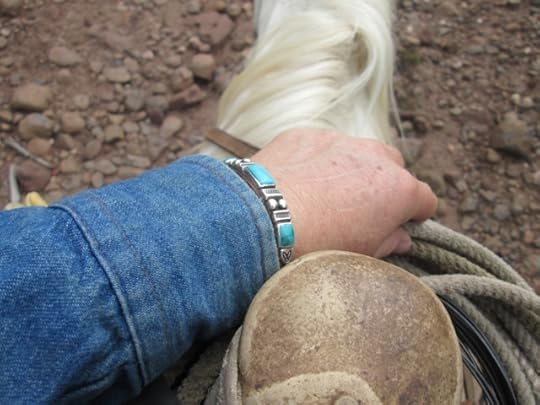
Amy’s wedding bracelet
for the golden moments, those moments I call Christmas Eve moments when everything that must be done is done, and the only thing left to do is to sit down and breathe, enjoy the sunset, drink a small toddy, smell the wood smoke, watch the cows we’ve gathered eat #1 alfalfa, talk about how the drive went and how amazing the sky is tonight. Yes. That moment. I collect them all day long. Perhaps I got one at sunrise when I finally got a cup of coffee, but before I put my mash’em flat on under my denim shirt. Or perhaps I will find one when I see a collard lizard catching some rays in the top of a baby cedar tree. Maybe I’ll have to wait for over an hour by Rincon Tank, holding the cows there while my husband
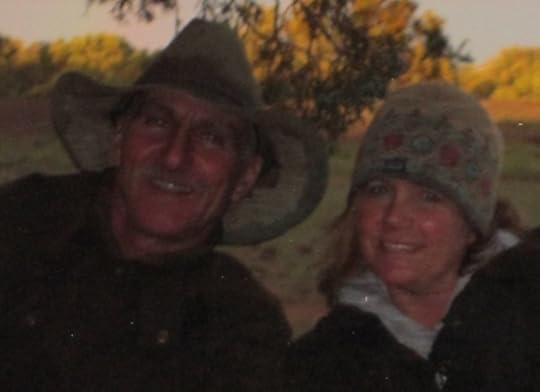
Amy with husband Gail Steiger
brings more, and a three day old calf will walk closer and closer to my horse, trying to figure out what we are. And I will laugh. Perhaps I will throw my loop well and true and manage my horse and my rope efficiently in the branding pen. Maybe I’ll get an attagirl when we are sorting off the shippers. Perhaps I will lie down in wool and canvas and watch a meteor shower as long as my eyes will stay open.
***********************************************************************************
Amy is very generously giving away one copy of Winter of Beauty and one copy of Rightful Place, to be chosen on or about Sept. 20th from people who leave a comment. Please state if you have a preference of which book you’d like.
From Winter of Beauty :
“The winter Bride wears diamonds. To those down below, she appears to be sleeping, locked inside a chastity belt of cold. She naps lightly behind the veil of ice and snow, letting it shield her from the sun and throw it back into the sky. But her chill is only skin deep. Inside her hidden folds and caves and recesses, the heartbeat of her lives and breathes and curls around the seeds of what will be. The winter Bride is pregnant, gestating the future, smiling quietly at the snores of the bears and the mountain lions, allowing all of the fertile places to swell and burgeon with the life that is to come. The winter Bride is holding a flood in deposit for the sun’s withdrawal in spring.“
This is the canvas on which Amy Hale Auker paints the lives of her characters. Shiney, the ranch owner; Monte, the foreman; Rafe, the old hand; Jody, the new hand; Blake and Brenna, who can’t seem to grow up even though they have a houseful of children. These, and many more, are waiting to show you how they live, love, work, and play in the shadow of the Bride.
***********************************************************************************
You can find Amy at the following sites:
http://www.amyhaleauker.com
https://www.facebook.com/pages/Amy-Hale-Auker-Author/182142398478630
http://www.amazon.com/Amy-Hale-Auker/e/B004I0MPB0/ref=ntt_athr_dp_pel_pop_1
http://www.goodreads.com/author/show/4725031.Amy_Hale_Auker
And you can buy her books at
http://www.pen-l.com
http://www.amazon.com/Rightful-Place-Voice-American-West/dp/0896726797/


August 1, 2013
POSTERITY
 While doing research for writing western historical novels I often read memoirs or autobiographies of the period. Not only are they informative but they also set the tone and bring me back in time. Yet they pose a query in my mind. Why were they written? What possesses someone to write a memoir or an autobiography, to tell their story? Has someone asked them to, as seems to be the case in Teddy Blue Abbott’s We Pointed Them North’? Is it a need to share their experiences and a belief that others may profit from knowing their life story? Is it an arrogant nature that believes everyone will be interested in what they have to say? No more, I should think, than what is written from any other author. Perhaps they are working through something, cleansing their mind? Or is it just putting down one’s life for posterity? Clearing their name, setting the record straight, laying down for posterity exactly who they were and what happened?
While doing research for writing western historical novels I often read memoirs or autobiographies of the period. Not only are they informative but they also set the tone and bring me back in time. Yet they pose a query in my mind. Why were they written? What possesses someone to write a memoir or an autobiography, to tell their story? Has someone asked them to, as seems to be the case in Teddy Blue Abbott’s We Pointed Them North’? Is it a need to share their experiences and a belief that others may profit from knowing their life story? Is it an arrogant nature that believes everyone will be interested in what they have to say? No more, I should think, than what is written from any other author. Perhaps they are working through something, cleansing their mind? Or is it just putting down one’s life for posterity? Clearing their name, setting the record straight, laying down for posterity exactly who they were and what happened?
Before anyone out there points out that my last months’ diary was a memoir, I’m well aware of that. I’m not analyzing why I filled empty white pages with a diary, nor do I want to go into the psychobabble of some people’s needs to work out their problems through writing. Who we are comes out in our writing no matter what we write. Whatever story we tell, that story is a part of us. But some people do write for a specific purpose. They write for posterity.
Helen Huntington Smith starts her preface to We Pointed Them North, which she co-wrote with Abbott, by saying, “This is a book of reminiscences by an old-time cowboy…” and “With the idea in mind of preserving a record, I have kept close to Mr. Abbott’s exact words.”(italics mine) Mr. Abbott was doing nothing more than recollecting his life story, which Ms. Huntington Smith was taking down, much as one might retell parts of your life to grandchildren. Since Ms. Huntington Smith had approached Abbott on another matter, it would be difficult to argue that the ‘old-time cowboy’ had any ulterior motives to having his story published—other than, understandably perhaps, financial.
Whether or not there were pure monetary reasons behind Pat Garrett’s The Authentic Life of Billy the Kid is, however, arguable. He certainly didn’t make much money from the book during his lifetime, and it wasn’t until reprints in the 1950s that it reached a wider audience. Garrett tells The Kid’s life story in order to build up to his part in The Kid’s death. In 1882, laying claim to having killed the most notorious outlaw of the day would certainly gain you both admiration and publicity, and Garrett does seem to manipulate the reader towards his own end. While he states openly that he is “incited to this labor…by an impulse to correct the thousand false statements which have appeared….” he certainly makes an attempt to stack the cards in his favor; an unbiased account this ain’t. First he builds up The Kid as a decent young man—even a ‘mama’s boy’—who goes wrong, so that it gives the reader the impression of being fair. Yet on the other hand, he makes no restraints on using language meant to inform the public of what a monster The Kid turned out to be. Phrases such as “Deeds of Daring and Blood, His name a Terror” would certainly make the average reader believe we were well rid of Billy the Kid, and the man who shot him was just short of sainthood. Furthermore, expressions such as “A faithful and interesting narrative” or “verified history of The Kid’s exploits” lend veracity to the text. As my colleague Paul Colt pointed out to me, “…it is the ‘Authentic’ life of Billy The Kid as opposed to what other life of Billy the Kid? The nineteenth century printed word had the cachet of fact. It clearly worked for Garrett.”
Colt visited the question of whether Garrett actually killed The Kid in an earlier post on this site, Billy the Kid and Pat Garrett — The Shadow of Doubt. Basically, in a memoir he published in 1933 titled The Death of Billy The Kid, Garrett’s deputy, John Poe, has disputed the sheriff’s claim of having killed The Kid. It’s interesting that he would have waited over forty years to debate Garrett’s assertion. But did Garrett foresee this argument? Was this book his testament to his own life, to what he saw as his one great accomplishment? It certainly doesn’t appear that, like Teddy Blue Abbott, he might have been writing for the grandkids.
Manipulative language also plays a part in 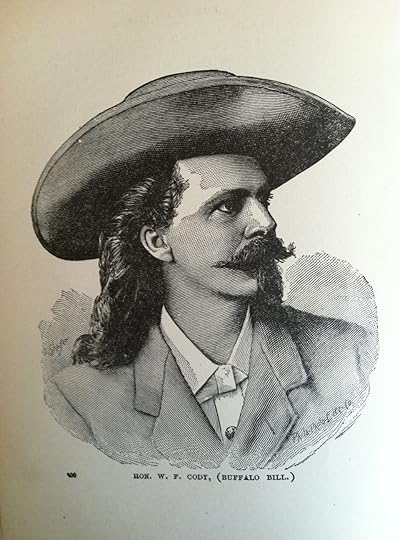 William F. Cody’s The Story of the Wild West and Campfire Chats, published in 1888. Cody’s story of the Wild West is basically his own autobiography along with three shorter biographies of Daniel Boone, Davy Crockett, and Kit Carson. Still only forty-three years old when he wrote the book, the title alone might prompt the reader to accuse Cody of hubris. His authoritative position is further enhanced by the use of ‘The Hon. William F. Cody,’ a title he was barely entitled to after being Justice of the Peace for a mere two months. In addition, the use of the rank of Col. towards the end of the book is pure invention; Cody was a scout in the Army although he did serve briefly during the Civil War, but he certainly never made it to Colonel.
William F. Cody’s The Story of the Wild West and Campfire Chats, published in 1888. Cody’s story of the Wild West is basically his own autobiography along with three shorter biographies of Daniel Boone, Davy Crockett, and Kit Carson. Still only forty-three years old when he wrote the book, the title alone might prompt the reader to accuse Cody of hubris. His authoritative position is further enhanced by the use of ‘The Hon. William F. Cody,’ a title he was barely entitled to after being Justice of the Peace for a mere two months. In addition, the use of the rank of Col. towards the end of the book is pure invention; Cody was a scout in the Army although he did serve briefly during the Civil War, but he certainly never made it to Colonel.
Since the copy by the frontispiece was written to 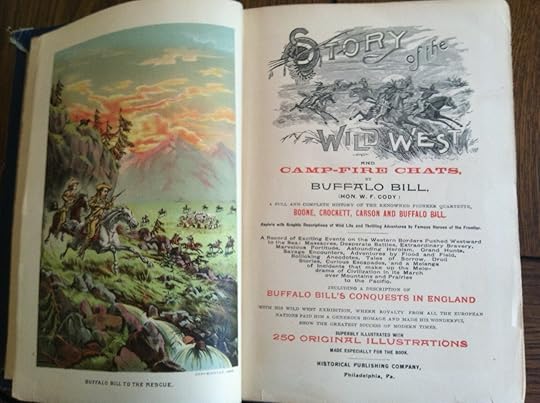 incite prospective readers to believe that within was the ‘The Full and Complete History of the Renowned Pioneer Quartet’ with “…massacres, desperate battles, extraordinary bravery, marvelous fortitude…’ and so on and so forth including ‘Buffalo Bill’s Conquests in England,’ I was certainly expecting about the most pompous and arrogant memoir ever written. So imagine my surprise when I came upon writing which is almost purely straightforward and unemotive. Not only that, but Cody is capable of admitting to various indiscreet incidences and mistakes he had made in the course of his life, such as encouraging the development of a town called Rome in KS on the basis that the railroad would make it a primary junction. It didn’t; the railway developed Hays instead. In addition, there are delightful moments of the hero’s modesty such as during his first trip east when he declares he had to get used to people recognising him. It was quite apparent that Cody had no part in the cover copy; possibly, he even added the Colonel
incite prospective readers to believe that within was the ‘The Full and Complete History of the Renowned Pioneer Quartet’ with “…massacres, desperate battles, extraordinary bravery, marvelous fortitude…’ and so on and so forth including ‘Buffalo Bill’s Conquests in England,’ I was certainly expecting about the most pompous and arrogant memoir ever written. So imagine my surprise when I came upon writing which is almost purely straightforward and unemotive. Not only that, but Cody is capable of admitting to various indiscreet incidences and mistakes he had made in the course of his life, such as encouraging the development of a town called Rome in KS on the basis that the railroad would make it a primary junction. It didn’t; the railway developed Hays instead. In addition, there are delightful moments of the hero’s modesty such as during his first trip east when he declares he had to get used to people recognising him. It was quite apparent that Cody had no part in the cover copy; possibly, he even added the Colonel 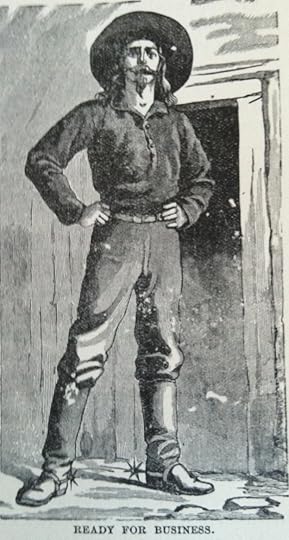 under duress of his publishers. But age forty-three for an autobiography? Even in the 1880s this was rather young.
under duress of his publishers. But age forty-three for an autobiography? Even in the 1880s this was rather young.
Money might well have been one reason. The tour to Europe cannot have been cheap despite the thousands who attended performances. Cody also takes a distinct pride in recounting his adventures and even ends the book with a letter of praise from General W.T. Sherman. And that, for me, summed it up. He was writing for Posterity.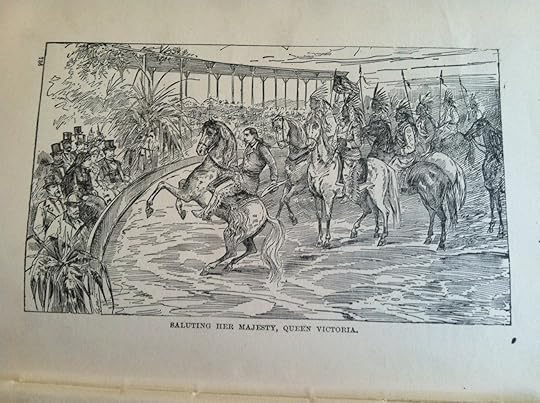
Posterity means different things to different people. Its definition is “future generations.” Yet, unless you are particularly famous, the likelihood of you writing specifically for the knowledge of future generations is not great. So why write an autobiography or a memoir? Is it just a darned good story you’d like to recount or was there some further reason that prompted you to set this specific tale to paper. And were you completely honest in the telling? Or were there things best left unsaid that went untold.
***********************************************************************
Sources:
We Pointed Them North, E.C. “Teddy Blue” Abbott with Helen Huntington Smith, University of OK Press, Norman, 1939
The Authentic Life of Billy the Kid, Pat Garrett, MacMay22, digital, 2009
Story of the Wild West and Campfire Chats, Buffalo Bill (Hon. W. F. Cody), Historical Publishing Co., Philadelphia, Pa., 1888
My thanks to Paul Colt for his input on Pat Garrett and Billy The Kid. Paul’s latest book, Boots and Saddles: A Call to Glory, will be published by Five Star on Dec.18. Paul’s book dealing with Pat Garrett And Billy The Kid, A Question of Bounty, will also be published by Five Star.


July 1, 2013
Two for the Road
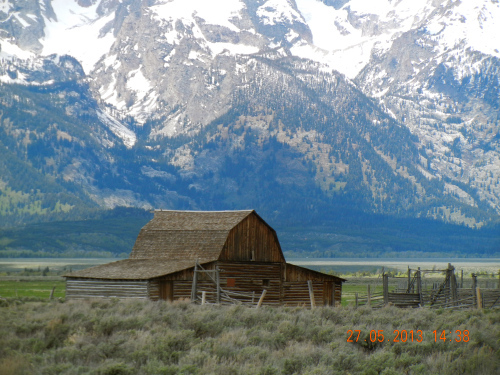 Thurs., May 23rd: Outside the big picture window, a plane descends through a threatening sky and bumps down onto the tarmac. Karen and I have been looking forward to this reunion for several months now, but the best part is that I am about to share my love of this section of Wyoming with a good friend and fellow writer. I’ve donned my best boots and Stetson to collect her at Jackson airport, happily situated right inside Grand Teton National Park.
Thurs., May 23rd: Outside the big picture window, a plane descends through a threatening sky and bumps down onto the tarmac. Karen and I have been looking forward to this reunion for several months now, but the best part is that I am about to share my love of this section of Wyoming with a good friend and fellow writer. I’ve donned my best boots and Stetson to collect her at Jackson airport, happily situated right inside Grand Teton National Park. 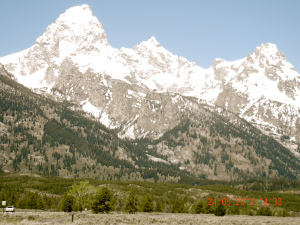
Her excitement and enjoyment at being here are palpable—but her weariness is also apparent. She’s been up since 4 am San Antonio time, 3 am Jackson time, and while her effort to be sociable and companionable is evident, so is her need for rest and an early night. Karen soldiers on. My daughter and her boyfriend, Daniel, phone via Skype from Colombia and we all get a good lesson in how to correctly pronounce Karen the Texas way—it’s something like Kieren. We all have a go and end up laughing our heads off, particularly Daniel who has now decided his American accent must be Texan, even if he’s going to be living in NYC.
At 5 pm Karen succumbs and goes to shower and get in her pjs for dinner. Without makeup, and pajama clad, my pint-sized pal resembles a 5 yr old before bedtime. But she marches bravely on until 9pm. As the sun sets in the west, Karen Casey Fitzjerrell is definitely out for the count.
Fri. May 24th: If the two of us could shut up for one minute, maybe we would have got to Grand Teton before noon. Whatever, Karen and I are truly awed by the grandeur of it all and decide to take a supposed 2 mile hike around Jenny Lake. 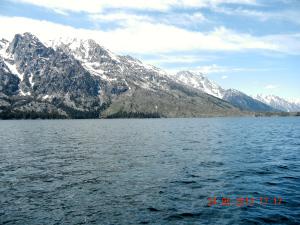 Unfortunately, I’ve misread the guidebook and this is not an easy hike. Not only that, but moose prints and bear scratchings on a tree encourage us to turn back and sign up for the 3pm scenic cruise with guide, a more leisurely way to take in the views. One of our fellow tourists inquires of the guide if he had said the mountains were eight hundred years old. This becomes a running gag between Karen and myself. A short drive to Jackson Lake rounds out the day. Karen not only volunteers to drive back to Wilson since I am unfortunately having eye problems, but marches in to make the most delicious chicken gumbo for dinner. What a perfect guest!
Unfortunately, I’ve misread the guidebook and this is not an easy hike. Not only that, but moose prints and bear scratchings on a tree encourage us to turn back and sign up for the 3pm scenic cruise with guide, a more leisurely way to take in the views. One of our fellow tourists inquires of the guide if he had said the mountains were eight hundred years old. This becomes a running gag between Karen and myself. A short drive to Jackson Lake rounds out the day. Karen not only volunteers to drive back to Wilson since I am unfortunately having eye problems, but marches in to make the most delicious chicken gumbo for dinner. What a perfect guest!
Sat. 25th: For years I’ve been hearing about the Moose-Wilson road, a partially unpaved lane into the back end of the national park. It is closed part of the year and I therefore envisage some torturous driving ahead when we decide to make it our thoroughfare into Grand Teton. I’m disappointed. Maybe I’ve driven too many back roads but this is easy as they come. We stop for a walk around Dornan’s before heading on to Menor’s Ferry and the Maude Noble Cabin. 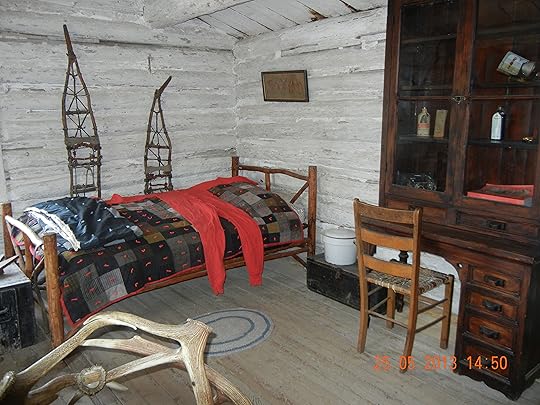 This is a step back in time with the cabin and shop furnished as it would have been during the period Menor lived there, from 1894. Cables and a replica ferry show how the service was run at a time when no bridges crossed the Snake River in this vicinity. Next stop is Chapel of the Transfiguration, built in 1925 to serve the surrounding ranches. Karen and I agree we would have no problem worshipping in such inspiring surroundings.
This is a step back in time with the cabin and shop furnished as it would have been during the period Menor lived there, from 1894. Cables and a replica ferry show how the service was run at a time when no bridges crossed the Snake River in this vicinity. Next stop is Chapel of the Transfiguration, built in 1925 to serve the surrounding ranches. Karen and I agree we would have no problem worshipping in such inspiring surroundings.
That evening is the first of rodeo season in Jackson. I’ve had the tickets in my hot little hand for some months as we are both keen. So keen in fact that we get there early enough to find parking and stroll around the Mountain Men Rendezvous next door. Unfortunately, the mountain men are off doing what mountain men do on a Saturday night and there is only one paltry tent open with some rather poor offerings. The owner, in beaded buckskins and ponytail, gives us a lecture on his lifestyle and sends us backing out of the tent and heading for an early hotdog.
Jackson’s rodeo is somewhat low-key. The rodeo princesses are trotted out in all their finery but there is no parade. A couple of the broncos seem confused as to what their part in all this is exactly, while a few of the cowboys appear to have lost their roping skills over the winter. The best part on this opening evening is the children’s events, including ‘bull’ riding. We do wonder, however, how any parent can let a three-year-old onto even a bull calf.
Sun 26th: Home all day working in pjs until my property manager stops by. Karen is incredibly polite to sit through an hour and a half of discussions on how to improve rentals. Eventually we are able to head off to the Stagecoach Inn for booze and recovery, although Karen is dd & limited on her intake. She is an expert dancer and I am new to most of this but we both dance with a number of older gentlemen. (Is this what I’m attracting now? Oh dear…) One old cowpoke is getting a bit close for comfort and I desperately seek K’s help. But he only wants to whisper in my ear, “I have a confession: I’m from Idaho and I’m a Democrat.”
After four Jim and Gingers I can dance almost anything but at 10pm the music stops and it’s home to K’s delicious leftovers.
Mon. 27th May: Somewhat recovered we hit the trail reasonably early to the town of Kelly. Kelly is small town eccentric America: yurts abound and every house has a large dog, old cars and strange buffalo sculptures outside. It’s obviously a town where people who wish to be withdrawn from the main arteries of the world live. We do a quick car tour and head on to the Cunningham Historic Home site. 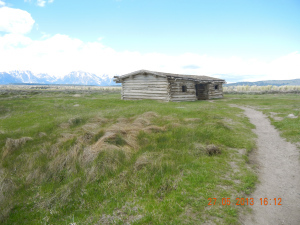 This is material for a book: the desolation but sprawling view, the loneliness in a landscape that is raw and untamed. Words fail me except for breathtaking. It never ceases to amaze me how people, with limited means of transportation and communication, could have lived in such isolation. And I wonder also if they appreciated their surroundings the way we value them today.
This is material for a book: the desolation but sprawling view, the loneliness in a landscape that is raw and untamed. Words fail me except for breathtaking. It never ceases to amaze me how people, with limited means of transportation and communication, could have lived in such isolation. And I wonder also if they appreciated their surroundings the way we value them today.
Up to Colter Bay for a long hike and ice cream, we head home exhausted.
Tues. 28th: The long drive to Yellowstone and up another couple of thousand feet! We avoid the multitudes of scenic turnoffs in favor of a chosen few and head to Old Faithful. On the approach, a tower of steam becomes visible in the distance through the trees. Yup, Old Faithful has blown.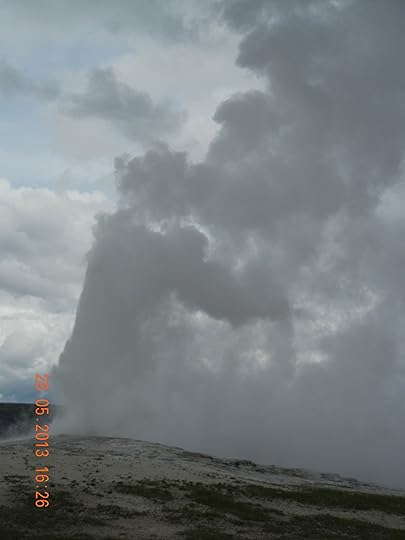 By the time we arrive, of course, there is another hour’s wait, just time enough for lunch and a quick whiz around the gift shop. And then… Old Faithful puts on its show. I’m a bit numb at the thought of all of that boiling going on in the earth under my feet. We head on to a geyser basin at West Thumb. Walking around the caldera we are dumbstruck…quite a feat to get the 2 of us to shut up. Witches’ caldrons of bubbling sulphuric brews are spotted about unstable ground through which walkways have been built.
By the time we arrive, of course, there is another hour’s wait, just time enough for lunch and a quick whiz around the gift shop. And then… Old Faithful puts on its show. I’m a bit numb at the thought of all of that boiling going on in the earth under my feet. We head on to a geyser basin at West Thumb. Walking around the caldera we are dumbstruck…quite a feat to get the 2 of us to shut up. Witches’ caldrons of bubbling sulphuric brews are spotted about unstable ground through which walkways have been built.  Even down by Yellowstone Lake shore the earth is spewing out poisons. We’re walking on one giant volcano! Rain blows in and the peaks spear clouds as a sheer curtain pulls over the scenery.
Even down by Yellowstone Lake shore the earth is spewing out poisons. We’re walking on one giant volcano! Rain blows in and the peaks spear clouds as a sheer curtain pulls over the scenery.
Weds. 29th: Our last full day and, with packing to do, we stick closer to home. I have several errands to run before I leave Jackson Hole to its summer visitors, and Karen has not as yet been into the town of Jackson. We opt to visit the museums but, sadly, the two of them are currently closed and we end up ogling books in the shop at the visitors’ center before lunch in the historic Wort Hotel.
On Thurs. 30th June it’s up and out to return the car and catch our flight. I’m sorry that K’s return to San Antonio will involve a six hour wait at Denver airport. For me, an hour’s delay on the flight out of Jackson means a mad dash through the airport to catch my flight to New York. This is not the ending I’d hoped for, but even as I sit there in the mephitic air of the plane, the Rocky Mts. disappearing in the clouds, I’m thinking through what adventures we can get up to next time Karen joins me.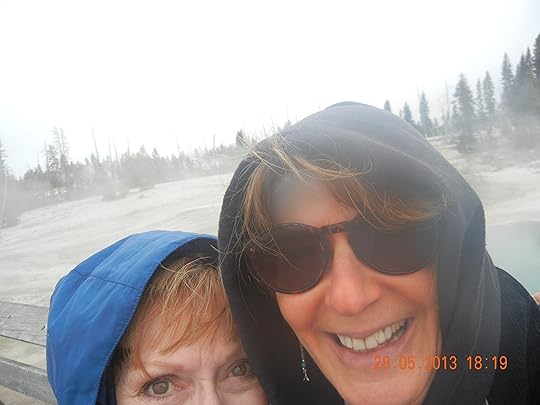
Karen Casey Fitzjerrell has written a companion piece to this post at http://karencaseyfitzjerrell.blogspot... Please head on over and read her side of the story.


May 31, 2013
An Interview with Rhonda Penders, Editor-in-Chief of The Wild Rose Press
Back in 2011, I was searching around for a publisher that would take on my western historical romance, Loveland. The name of The Wild Rose Press kept cropping up. It held the title of Best Publisher of the Year from Preditors and Editors (http://www.preditorsandeditors.com/) and had a well-earned reputation for good communication with their authors and a high level of professionalism. Today, Rhonda Penders is my Editor-in-Chief and I’m honored and delighted to have the opportunity to interview her here.
and had a well-earned reputation for good communication with their authors and a high level of professionalism. Today, Rhonda Penders is my Editor-in-Chief and I’m honored and delighted to have the opportunity to interview her here.
Penders and her business partner, R.J. Morris, started TWRP in May 2006. Under their leadership the company has grown to not only include over 1600 romance titles in both e-format and print, but in 2013 they also opened their doors to submissions in other genres, including women’s fiction, historical, erotica and mystery/suspense. In 2012 they started Wildflowers Books, www.wildflowersbooks.com, to assist authors who wanted to self-publish but needed some help with the basics. In January, 2013 they were awarded the Best Publisher of the Year title for the fifth year straight.
Penders’ writing background includes everything from small town newspaper articles to western romances under the pen name of Roni Adams. She resides in Upstate New York with her husband and three sons.
 1) Rhonda, I’m delighted to have you here. Let me start by asking what gave you the idea and the impetus to start a publishing house? I take it you didn’t just wake up one morning and think, gee that might be fun…?
1) Rhonda, I’m delighted to have you here. Let me start by asking what gave you the idea and the impetus to start a publishing house? I take it you didn’t just wake up one morning and think, gee that might be fun…?
Actually, that’s pretty close to the reality. My writing friend, RJ, was frustrated with the way publishers treated authors and she was convinced we could do it better. The old adage ‘find a niche and fill it’ certainly applied when we decided to open a publishing house by authors for authors. We came up with the idea in mid-March of 2006 and by May 1 we were open for business.
2) Did you choose to publish Romance initially because that is what you write and presumably read or were there other factors?
Starting a business is hard enough without trying to learn something new. We figured the best thing to do was focus on our expertise which was romance. We brought up several people who we felt were experts in their subgenre, for example erotic romance and historical romance, and we put them in charge of those departments.
3) Who thought up The Wild Rose idea, by the way; was there any special association behind that or was it just an excellent marketing ploy?
It takes a really long time to come up with the name of a company. Something that is catchy, meaningful, and not lame to be honest. I started seeing roses – red roses for hot romances and white roses for sweeter romance for example. From there we thought how cool it would be to have a greenhouse where writers could “clip” articles, etc. The name sort of came from all that although originally we wanted to be called Wild Rose Publishing but the domain was taken. It took a few tweaks before we settled on The Wild Rose Press so we could acquire the proper domain.
4) The company has expanded quite a bit in the last couple of years. In the best of all possible worlds, what would you like for the future of TWRP? Any thoughts of taking on the Big 6?
We never think about how big we’d like to go or taking on anyone, we just let the company do what it does. We constantly learn new techniques and do our best to stay on the cutting edge of technology but we don’t plan for the next step. We like to let things happen naturally, although not in a naïve way—we are certainly guiding things along but to expect it to do this or that isn’t what we do.
5) You’ve said that the company’s premise was to be a ‘kinder and gentler publishing house.’ How did you set about doing that?
The very first thing we did was implement a “no form rejection letters” policy. All rejection letters are personalized and detailed. We give the writer our reasons for the rejections, not just a “thanks but it’s not for us” letter. Second, we made it a policy that all emails would be answered within 24 business hours. Communication between the company and the writer would be a top priority. We knocked down these walls that kept that editor and writer from speaking to one another. We were determined and still are that this company would be a partnership between the publisher, editor and author. Honestly, without any one of those people you don’t have a company.
6) TWRP recently opened their self-publishing division. I’m someone who would be reluctant to go that route; I feel I need the validation of a publishing house and I’ve been stung into buying a self-published book that turned out to be the worst thing I’ve ever read. But I’ve also read excellent self-published books. What are your feelings on self-publishing?
Personally, I think there needs to be some standard for publishing. I have no issue with anyone taking control of their own writing career but too many authors write something and then literally slap a cover on it and put it up for sale. There needs to be some quality control. I cringe thinking of the reader who buys a product, even if its only .99, and gets ripped off because the material is poorly written and full of errors. I think it’s watering down the books and allowing writers who aren’t very good to publish alongside writers who truly deserve to be published and read. It has saturated the market and the buying public has no way of knowing which self-published book is quality and which is junk.
7) Promotion is a huge problem for many authors. I know TWRP has an excellent marketing person but I wonder if you have ever considered the possibility and usefulness of public relations personnel for the authors? Or is social media the be-all and end-all?
We have never had the need or the budget for a full time public relations department but our Marketing Director works tirelessly to promote the company and teach authors how to promote. I truly think in today’s world it’s all about doing it yourself and to pay someone to do what an author can do is simply not going to happen. Social media is a tip of the iceberg in the internet marketing age but it is a very useful tool when it comes to getting the word out about releases, upcoming events, etc.
8) Let me ask you, are you a writer or a publisher first –or something else entirely?
I use this example all the time – I’m like the woman who loves to bake cakes so she opens a bakery and she is so busy running the business of the bakery that she never bakes another cake. The sad reality is that once you own a business, in order to give it the dedication it requires, something has to give and for me what took a back seat was my own writing. I still write but I rarely am able to do more than one short story or full length in a year. My loyalty is to my authors and they come first.
9) How difficult is it to combine your family’s needs with two careers?
Actually, these days, it’s a lot better. For the first six years of the company I worked a full time job in addition to running the company, in addition to taking care of my house and family. Things are much better now that I can devote my attention to TWRP and my family. As I said above, my writing takes a backseat. While I still write, I don’t promote my writing or spend any time trying to sell it. I simply write a story every year to keep myself motivated and, as any true writer can attest, because I can’t not write.
10) I’m under the impression that you love the west—or at least Texas—as much as I do. Where did that come from?
This is something I’ve wondered my whole life. If I wanted to get into something really deep I could wonder about past lives or something but I really hate to go that route. Ever since I was young, I have had a fascination with Texas. My father’s favorite song is “The Yellow Rose of Texas” so maybe that was always part of it, I don’t really know. He certainly wasn’t from Texas either. I wrote Texas cowboy romances, and I researched extensively over the years. When I turned 40 I managed to get myself to Texas and it truly felt as if I was coming home to a place I’d never been before. It was weird and wonderful at the same time.
11) And I’m curious to learn if you have a favorite book?
Not really. I’ve read so many books over the years that I would be hard pressed to name a favorite. I have authors that I enjoyed back in the day such as Janet Dailey and Nora Roberts (her old stuff not her new), and these days I enjoy Susan Wiggs but to say I have a favorite, not really. I have a favorite type I suppose. I love romance, of course, but I really love romances that have a sense of community. I like series where you meet the characters and spend time with them book after book. I don’t like the story to end I guess. I tend to write that way as well. I also really enjoy a well written time travel. It’s always fascinated me and someday I hope to write one but I need a lot of time to research and that just isn’t on the agenda.
12) Well, Rhonda, with so many facets to your life, I’d really like to know where you get all your energy? Do you ever manage to take vacations?
I’ve always been very organized, very determined and very energetic. I’m an early riser and can accomplish more before 8:00 a.m. than most folks can all day. That’s not to say I’m wonderful, I can’t keep my eyes open past 9:00 p.m. and I can’t write anything at night but I do like to get the things off my ‘to do’ list each day or it bugs me. As for vacation, yes of course. My husband and I always took our sons on vacation, every year, and we also camped most weekends in the summer when they were young. These days we have a place on Lake Ontario where you can find us every weekend from May to September. We also take several trips throughout the year. Last year we took a cruise to Alaska. This year we are spending some more time on our favorite ranch in Bandera, Texas for several days. I love vacations; and think everyone should take one even if it’s only a short weekend away.
13) And finally, how do you see the future of publishing? Any plans you’d like us to know about for TWRP?
All signs today are pointing to more and more audio books what we used to call books on tape. Readers want to be read to while they do something else and the need is huge right now. We have managed to get a few of our catalog into audio but its time consuming and expensive so the companies that do the audio for us can’t take on too many titles in a year. I hope that changes. I don’t know but I do hope that some quality control will take place when it comes to books that are self-published in the future. It’s hard to imagine where we’ll be in five years – who would have ever thought publishing would be where it is today if you look back five years. As for TWRP, we are just going to keep our noses to the grindstone and keep helping our authors create quality stories that everyone can feel good about. We are going to continue to try to work on audio books as I think that is a market that we really need to focus hard on.
Thanks so much for agreeing to do this interview. I know you’ve been buried under mountains of work so it truly is greatly appreciated.Andrea, it is always a pleasure talking with you. I’m so pleased to have you as part of our garden of roses. Thanks for asking me to be a part of your blog.


May 2, 2013
Someday I’ll Write That Story: Becoming Lost In Research
 When I first joined Women Writing the West in 2011, the name of Alice Trego seemed to be everywhere. Not only had Alice served as the group’s President, but she had also held positions as Treasurer, Newsletter Editor, Catalog Editor and VP Conference. In addition to giving her time in these demanding posts, Alice had also spearheaded the group’s LAURA awards—their short story competition for members—and had help edit and redesign the WWW website.
When I first joined Women Writing the West in 2011, the name of Alice Trego seemed to be everywhere. Not only had Alice served as the group’s President, but she had also held positions as Treasurer, Newsletter Editor, Catalog Editor and VP Conference. In addition to giving her time in these demanding posts, Alice had also spearheaded the group’s LAURA awards—their short story competition for members—and had help edit and redesign the WWW website.
Alice’s own writing career started in the late 1980s, writing for a column called “Conversations” in Missouri’s Suburban Journal newspapers. By the 1990s, she had expanded her portfolio to include historical non-fiction and fiction, garnering notice in several competitions. Although a journalist by profession, Alice’s main area of interest is early 1800s western history. She now writes Native American and other historical fiction stories, often losing herself in her research. Alice says that unknown facets of history let themselves be known to her, and she has to investigate them further and determine if they will have their own place in her stories.
Currently she is researching a well-known Montana family for a book-length creative non-fiction project. She remains a member of WWW as well as Western Writers of America. I’m delighted to have Alice Trego here as my guest.
+++++++++++++++++++++++++++++++++++++++++++++++++++++++
Someday I’ll Write That Story: Becoming Lost In Research
By Alice Trego
American playwright Wilson Mizner is credited with saying, “Stealing from one is plagiarism, stealing from many is research.”
There have been numerous variations of this quote since Mizner made the remark while working in early 1900s Hollywood. However, versions of his remark in the decades before and after seem to allude to the same premise – research entails a lot of legwork, scrutiny and investigation so that authenticity is key in stories.
As a journalist, I learned early in my writing career that seeking more than two resources is a must. As a writer, I adhere to Mizner’s “philosophy” so that both my historical non-fiction and fiction have depth of history . Consequently, I have a tendency to become lost researching history for my manuscripts. I become so engrossed in finding the nuggets of history that I forget I have to write, too. 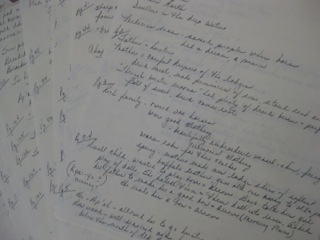 I’ve also discovered that sometimes trickles of information appear before me in the strangest scenarios. For instance, on one occasion I ordered a book from a museum gift store because I knew the material would be exemplary. This hardcover contained beautiful photos of busts and statues by a well-known western bronze sculptor, Bob Scriver. When I opened the book, I turned directly to a picture of a bust of a famous female Indian warrior. A couple of days later, I received a publication from a different museum where I have a membership, and a story featuring the same female warrior caught my eye. The article mentioned a book written about her in the early 1900s and I knew I had to search for that book and read her story. I did some research and the path led me to the Special Collections department of the J. Willard Marriott Library at the University of Utah. Needless to say, this woman has intrigued me for many years since that hardcover showed up in my mailbox. Someday I will write her story.
I’ve also discovered that sometimes trickles of information appear before me in the strangest scenarios. For instance, on one occasion I ordered a book from a museum gift store because I knew the material would be exemplary. This hardcover contained beautiful photos of busts and statues by a well-known western bronze sculptor, Bob Scriver. When I opened the book, I turned directly to a picture of a bust of a famous female Indian warrior. A couple of days later, I received a publication from a different museum where I have a membership, and a story featuring the same female warrior caught my eye. The article mentioned a book written about her in the early 1900s and I knew I had to search for that book and read her story. I did some research and the path led me to the Special Collections department of the J. Willard Marriott Library at the University of Utah. Needless to say, this woman has intrigued me for many years since that hardcover showed up in my mailbox. Someday I will write her story.
Aside from the many freakish ways that tidbits of history come to me, I also have various places I routinely conduct my research –
Internet Search – While it’s said that writers should use caution when researching the internet, I mainly use the world wide web as a preliminary to get an idea of what I should be looking for before I trek to the library or research on site. I’ve recently discovered two great sites that make my beginning research ideal and lead to many other resources – www.entireweb.com and www.heritage-history.com
Libraries- I could spend hours in the library. Most city libraries are known for their wonderful children’s sections, and it’s here that I first look up the subject I want to write about. By reading a children’s book first, I learn the important facets of the topic before I delve deeper. At the university libraries, I always make sure I check out their Special Collections area because here is where the small nuggets of my research have yielded bigger nuggets of information. Besides, there is something awe-inspiring about being in the midst of a library’s Special Collections. When I had my first introduction to this collection, I had to leave all my belongings in a locker, go through the glass door entrance, and inquire about my subject. Once that process was completed, I was told to sit down at one of the tables while the researcher went into the long, archive-filled hallway to retrieve the specific book I wanted. 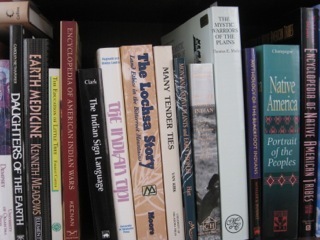 They gave me a short stack of unprocessed yellow paper on which to write my notes and I could only use the pencil they provided. No need for white gloves, though, as the book I wanted to read was in good condition. Sometimes when I travel to the place where my story is set, I’ll take a trip to the library. I let the reference librarian know what subject I’m researching and they retrieve specific books for me. If I run out of time, I will jot down titles and authors of the books I was unable to read/skim and order them later, perhaps from www.powells.com, which specializes in rare and used books. Or I might order them from www.amazon.com or www.barnesandnoble.com
They gave me a short stack of unprocessed yellow paper on which to write my notes and I could only use the pencil they provided. No need for white gloves, though, as the book I wanted to read was in good condition. Sometimes when I travel to the place where my story is set, I’ll take a trip to the library. I let the reference librarian know what subject I’m researching and they retrieve specific books for me. If I run out of time, I will jot down titles and authors of the books I was unable to read/skim and order them later, perhaps from www.powells.com, which specializes in rare and used books. Or I might order them from www.amazon.com or www.barnesandnoble.com
Magazines - Because I have many museum memberships, I have the privilege of receiving their publications via snail mail. Some will yield information for my stories, some will not. All the same, I save these magazines because the information contained within their slick covers is invaluable to me and I never know when a bit of history will pop up.
Books - As a writer, I have a fondness for books. My bookshelves hold an array of books, arranged alphabetically, that I have collected through the years and are mostly about the subjects I’m passionate about– Native Americans especially. I covet my Time/Life Books titled “The Old West” 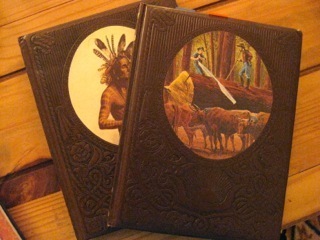 wherein every detail that a historical writer wants/needs to know about the Old West is included in these wonderful books.
wherein every detail that a historical writer wants/needs to know about the Old West is included in these wonderful books.
I have several museum and historical society memberships which afford some excellent research opportunities –
Montana Historical Society - www.montanahistoricalsociety.org – Since I feel a kinship to the history of Montana, I joined the historical society there so I’d be able to keep abreast of all information received either by snail mail or e-mail. Now that most historical societies are preparing their archives for digital research, preliminary searches can be done online before a possible on-site visit to dig through the society’s many collections.
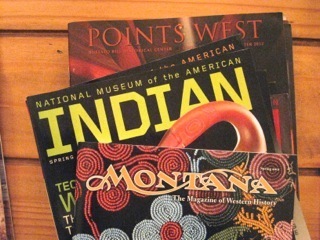 The Northwest Montana Historical Society (Museum at Central School) – www.yourmuseum.org – When I had the opportunity to visit Kalispell, MT to do some research, a friend of mine introduced me to staff members at the Museum at Central School. I gave them a little information about my subject, and they were able to pull folders from their attic archives.I joined the society for two years, and a benefit of that membership allowed a certain amount of research with the knowledgeable staff, one on one, as well as having a set amount of copies made for me. I came home with an abundance of information.
The Northwest Montana Historical Society (Museum at Central School) – www.yourmuseum.org – When I had the opportunity to visit Kalispell, MT to do some research, a friend of mine introduced me to staff members at the Museum at Central School. I gave them a little information about my subject, and they were able to pull folders from their attic archives.I joined the society for two years, and a benefit of that membership allowed a certain amount of research with the knowledgeable staff, one on one, as well as having a set amount of copies made for me. I came home with an abundance of information.
Buffalo Bill Historical Center – www.bbhc.org – I’ve belonged to this icon in Cody, WY for many years. Even though I have yet to discover a special nugget of research there, their publication, Points West, is an invaluable resource for me.
National Museum of the American Indian – www.nmai.si.edu – Because I have an affinity for Native American history, I joined NMAI in Washington, DC,. Their slick publication yields some highly informative articles about different Native American cultures. In addition, my membership dues help maintain the museum and its many exhibits.
I am fortunate to have many resources available to me for my historical researches. I’d like to think that perhaps Mizner wasn’t fully aware that this writer of historical stories who tends to become lost in research would take his “prophetic” words to heart.
*********************************************************************** Alice can be found on LinkedIn — www.linkedin.com/pub/alice-d-trego/1b/3b5/8b3/ — as well as on Facebook https://www.facebook.com/alice.trego Her website, www.alicetrego.com is under construction.


April 1, 2013
Whither A Transcontinental Railroad?
Anyone who read last month’s blog will know I recently acquired an engraving of a Transcontinental Railroad train stuck in a snowdrift. The photo of this is below, in the March post. The 1872 news article accompanying it briefly discussed the various routes that had been considered for the TRR, and this in turn raised a few questions. The article seemed to almost insist that the only point upon which the decision of the route had been based was geography. This didn’t sit quite right with me; I knew from fellow author Paul Colt that shenanigans had surrounded the construction of the TRR, so I turned to Paul to find out more about the decision of the route.
Paul’s book, Grasshoppers in Summer, was a Spur Award Finalist in 2009. It deals with the Fort Laramie Treaty of 1868, which ended Red Cloud and the Lakota’s war for the Bozeman Trail. The treaty gave Red Cloud and the Lakotas control of the Black Hills and their Powder River hunting grounds through which ![UnionPacific[1]](https://i.gr-assets.com/images/S/compressed.photo.goodreads.com/hostedimages/1380926263i/3311538._SY540_.jpg) the Bozeman Trail ran. But Red Cloud’s triumph proved an empty victory once the transcontinental railroad went through a year later, making the Bozeman Trail redundant. Paul’s novel, Case File: Union Pacific, deals more directly with the TRR in that it is based on the Credit Mobilier scandal over the funds for construction of the railroad.
the Bozeman Trail ran. But Red Cloud’s triumph proved an empty victory once the transcontinental railroad went through a year later, making the Bozeman Trail redundant. Paul’s novel, Case File: Union Pacific, deals more directly with the TRR in that it is based on the Credit Mobilier scandal over the funds for construction of the railroad.
So, whom better to ask to do some research on the route of the transcontinental railroad than Paul Colt?![BAND[1]](https://i.gr-assets.com/images/S/compressed.photo.goodreads.com/hostedimages/1380926263i/3311539._SX540_.jpg)
Whither A Transcontinental Railroad?
One of the most enjoyable aspects of writing historical novels is the research. Most fiction writers have experienced some form of the phenomenon where the characters take over and move the story in some unexpected direction. Once in awhile, historical research can also take an unexpected turn.
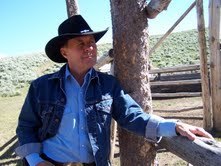
Paul Colt
When Andi first suggested the idea of looking into the politics of choosing a route for the transcontinental railroad, I thought it sounded intriguing. It wasn’t long before I discovered a puzzle full of familiar dots with unfamiliar connections.
I’ve long had a fascination with the transcontinental railroad. In its day it was an engineering achievement of monumental proportions. It played an important part in two of my books. I thought I knew something about this chapter in our history. What I discovered in researching the route selection controversy is what seems to be another of those unexpected historical twists.
The notion of a railway to the Pacific seemed a natural progression in the nation’s manifest destiny as early as the 1840’s. The idea took root following the 1848 acquisition of western territories from Mexico and the discovery of gold in California the following year. The California gold rush in particular highlighted the need. Reaching the nation’s western-most possession could take as much as a year of dangerous overland travel or at best months by sea. As a practical matter there was no way to defend California. A Pacific railroad became a national priority. The question of what route it should take quickly emerged as a lightening rod for political controversy.
In 1853 Congress ordered a survey for the purpose of choosing the most practical and economic rail route from the Mississippi River to the Pacific Ocean. The War Department commissioned five survey parties. Three parties would proceed west from the Mississippi, exploring alternate routes through the northern plains, central plains to the Rocky Mountains and the newly acquired southwestern territories. Two parties would proceed east from northern and southern California to explore passages to join the westbound routes.
The survey teams finished their work in the fall of 1854. The War Department put forward its recommendation of the southern route preferred by Secretary of War, Jefferson Davis. Northerners in congress thought the recommendation reflected a certain regional bias. In fact, the controversy over which route to select quickly bogged down in differences over the future of slave and free-state territories.
This is where the connections between familiar dots became unfamiliar to me. I never saw the transcontinental railroad as a catalyst for the events that followed. It is possible I dozed off during that American history class in my high school junior year. It was fourth period, right after lunch in a large lecture hall so anything is possible. As I recall, for test purposes, we were more concerned with events and their dates than cause and effect. The controversy stirred up by selecting a route for the Pacific railroad drove straight at the heart of the slavery issue.
At this point it is useful to recall the Missouri Compromise of 1820. The United States had managed to maintain an uneasy balance of power in the Senate between slave and free-states until 1818 when Missouri applied for admission to the union as the twenty third state. Northern interests proposed to ban slavery in Missouri despite the presence of slave holdings in the territory. Southern interests were strongly opposed to any admission that would upset the balance of power in the Senate which protected their longstanding economic interest in the institution of slavery. The issue remained contentious until Maine applied for statehood, at which point both could be admitted, while maintaining the balance of power.
The Missouri Compromise, offered by Henry Clay at the time, sought to put the advance of slavery to rest on some more permanent basis. By its provisions, Louisiana Purchase territories west of Missouri and north of that state’s southern border would be admitted to the union as free-states. Territories south of the Missouri southern border would be admitted as slave states. The effect was to defer for a time territorial disputes over slavery. That equilibrium would necessarily be upset by the routing of a Pacific railroad. Both northern and southern interests rightly reasoned that building the Pacific railroad would spread settlement westward along the rail route and with it the territorial march to statehood.
As eastern railroads built west, they were drawn to favor a central route by
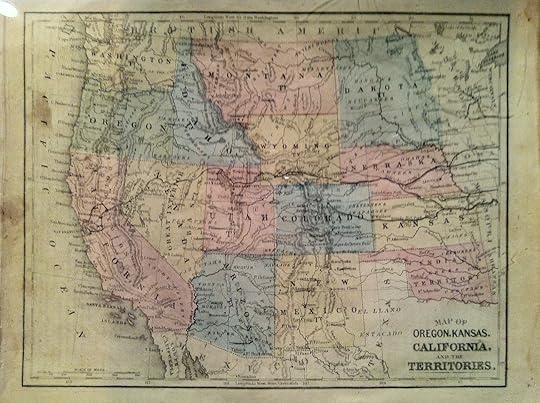
1879 map showing the final route of the TRR
commercial interests in Chicago and Mississippi River commerce concentrated in St. Louis. A central routing clearly favored formation of free-states, thereby putting an end to the Senate balance of power. With antislavery sentiment growing in the north, the south saw such a routing as an existential threat to its economic way of life. No agreement could be reached on a route for the Pacific railroad.
In 1854 Senator Stephen A. Douglas, Chairman of the Senate Committee on Territories, introduced the Kansas-Nebraska Act, proposing creation of two western territories along with repeal of the Missouri Compromise. This created the impression in the minds of Missourians and their southern sympathizers of a return to the balance of power formula for expansion. Northern interests were not fooled. A bitter floor fight ensued. The deadlock was broken by the addition of a ‘Popular Sovereignty’ provision to the act, which allowed inhabitants of the territories to determine the slavery issue. This well intentioned bit of ‘perfectly reasonable foolishness’ enabled Douglas, with the support of President Pierce and southern interests, to pass the bill into law.
When the slavery issue reached the ballot in Kansas, Missourians poured into the state to elect a pro-slavery territorial government over the objection of Kansas residents. This prompted Kansans to elect their own antislavery government. The issue bitterly divided the new territory to the point of bloodshed. Kansas burned as a harbinger to the wider conflict to come.
My historical recollection of that period is framed around John Brown and the abolition issue. I don’t remember the Pacific railroad route contributing to the dispute. Maybe if I lived in Kansas or Missouri I might have gotten a deeper appreciation for the dispute in my American History courses, but I didn’t get that connection from mine. Either I dozed off and really deserved that B, or the connection was overlooked.
The Pacific railroad remained a dusty stack of survey maps until 1861 when the boil that became the war of secession burst. Southern legislators resigned their seats in congress and returned home. Opposition to the central Pacific route disappeared. Union Pacific and Central Pacific proposals for a transcontinental railroad were put forward and approved by Congress in 1862. The Herculean construction effort would not complete until 1869, just in time to bind the nation’s reconstruction in economic union. American commerce and defense could now traverse the continent from Atlantic to Pacific in relative safety and comfort and do so in the breathtaking span of ten days.
Once in awhile, historical research takes an unexpected turn. I’ve had the experience three times in my writing career. All three gave me an idea for a book. Do the politics surrounding the transcontinental railroad route rise to that level? Not for me. Not enough guns, gals and horses for a novel. It’s probably already been done by some serious historian. I am interested to hear what you think. Is the connection between the transcontinental rail route and the slavery issue overlooked; or is it old hat? Either way the research was interesting. Thanks Andi.


March 4, 2013
LOSING THE WEIGHT OF WORDS
This past Christmas my daughter, knowing her mother’s fanaticism about owning anything to do with the Old West, bought me something that was within her budget and definitely within my scope of interest. It is a wood engraved illustration from Frank Leslie’s Illustrated Newspaper, March 30th, 1872. It depicts ’Wyoming Territory—A Passenger Train of the Union Pacific Railroad in a Snow-Drift, Near Wyoming Station’ from a sketch by C. B. Savage. 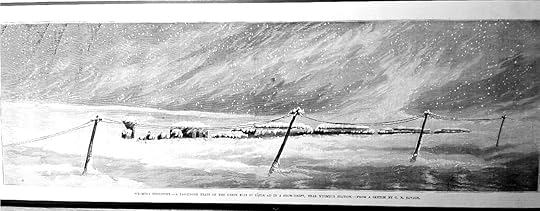 While the illustration is soon to be framed and find a place on my wall, I was also fascinated by the accompanying news article, which uses a language not often employed in modern journalism. “The actual troubles of east-bound passengers began at Ogden. Previous to reaching that point, the travelers were quite jolly over the novel garb that nature had assumed, and fashioned brilliant stories to please and excite their far-away friends. But…when provisions grew scarce, and patience rebellious…and the huge drifts swept revengefully over the trains…when the game and song, the story and flirtations had lost their charms…” You get the picture. The newspaper was a weekly illustrated literary and news magazine which ran from 1852 until 1922. During that time it covered news stories from the Civil War through WWI, and its illustrations evolved from engravings like mine through photographs and early cover illustrations by Norman Rockwell.
While the illustration is soon to be framed and find a place on my wall, I was also fascinated by the accompanying news article, which uses a language not often employed in modern journalism. “The actual troubles of east-bound passengers began at Ogden. Previous to reaching that point, the travelers were quite jolly over the novel garb that nature had assumed, and fashioned brilliant stories to please and excite their far-away friends. But…when provisions grew scarce, and patience rebellious…and the huge drifts swept revengefully over the trains…when the game and song, the story and flirtations had lost their charms…” You get the picture. The newspaper was a weekly illustrated literary and news magazine which ran from 1852 until 1922. During that time it covered news stories from the Civil War through WWI, and its illustrations evolved from engravings like mine through photographs and early cover illustrations by Norman Rockwell.
As the newspaper progressed and changed so, no doubt, did its language. Language like clothing changes with time. I, as a woman, am no longer in need of the millinery goods advertised on the back of the article and I wouldn’t wear an organdy tunic even if it were trimmed with lace. Nor would I talk or write in such  a flowery style. Heading over to Peterson’s Magazine, the story is similar. Peterson’s was started by the same team who published The Saturday Evening Post, although it obviously didn’t last quite so long. It began in 1842 as a cheaper version of the popular Godey’s Lady’s Book, sort of the Mademoiselle to Vogue perhaps? My August, 1873 issue contains patterns for such essentials as a ‘Lady’s Seaside Jacket’ and a ‘Tatting Basket,’
a flowery style. Heading over to Peterson’s Magazine, the story is similar. Peterson’s was started by the same team who published The Saturday Evening Post, although it obviously didn’t last quite so long. It began in 1842 as a cheaper version of the popular Godey’s Lady’s Book, sort of the Mademoiselle to Vogue perhaps? My August, 1873 issue contains patterns for such essentials as a ‘Lady’s Seaside Jacket’ and a ‘Tatting Basket,’ 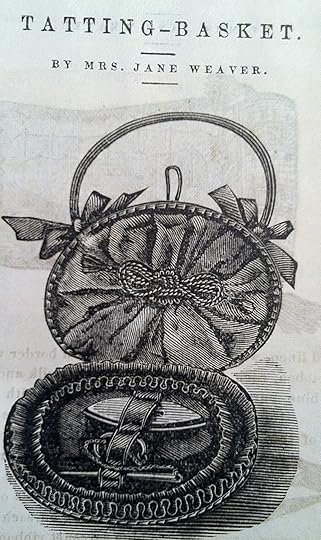 while my August, 1878 edition has a song titled ‘Yesterday.’ “We stood amid those bow’rs,/When last I wept adieu,/ Surrounded by fair flowers,/Of many a brilliant hue…“ Paul McCartney it ain’t. So this leads me to the question: Why, when we are basically still speaking the same English, using the same words (more or less) are we not writing in such florid phrases? This is not just a question of usage, of alright vs all right, or of words being employed in ways they hadn’t previously been used (I’ll buy that!), or of words no longer being spoken because they have taken on alternative meanings, e.g. “gay.” It’s a question of fashion in the use of words. We talk about the vitality of the English language, how it continues to adapt, accept new words from other languages, moderate the use of still others while continuing to ‘invent’ still more. Yet in truth, the way we speak and write those words has somehow become pared down, the figures of speech more direct, similes and metaphors more restrained.
while my August, 1878 edition has a song titled ‘Yesterday.’ “We stood amid those bow’rs,/When last I wept adieu,/ Surrounded by fair flowers,/Of many a brilliant hue…“ Paul McCartney it ain’t. So this leads me to the question: Why, when we are basically still speaking the same English, using the same words (more or less) are we not writing in such florid phrases? This is not just a question of usage, of alright vs all right, or of words being employed in ways they hadn’t previously been used (I’ll buy that!), or of words no longer being spoken because they have taken on alternative meanings, e.g. “gay.” It’s a question of fashion in the use of words. We talk about the vitality of the English language, how it continues to adapt, accept new words from other languages, moderate the use of still others while continuing to ‘invent’ still more. Yet in truth, the way we speak and write those words has somehow become pared down, the figures of speech more direct, similes and metaphors more restrained.
I’m not “weeping adieu” here to such extravagantly embellished phrases as those above, but perhaps we are losing something in going for the ‘quick fix,’ the direct approach in English usage. Are we not losing  words? I read recently that readers no longer have time to ascertain the meaning of obscure words; they do not want to be made to feel as if they are doing homework. Writers are competing with television, internet, video games and a host of other distractions which are not as ‘taxing’ perhaps as reading a well-written novel and can more easily be put aside as time permits. So what effect will this have on English usage?
words? I read recently that readers no longer have time to ascertain the meaning of obscure words; they do not want to be made to feel as if they are doing homework. Writers are competing with television, internet, video games and a host of other distractions which are not as ‘taxing’ perhaps as reading a well-written novel and can more easily be put aside as time permits. So what effect will this have on English usage?
One further idea that struck me while strumming through the bunch of ancient newspapers in my possession was that our concerns don’t seem to have changed very much, despite the evolution of fashions in and out of language. On the cover of London Opinion from 23 September, 1911, there is a series called ‘Whipped Topics.” One of the topics, which I believe we would today call “News Briefs,” states, “Paris has started an anti-talking machine league…” Sounds to me just like an anti-cell phone or anti-texting movement. OK, so the ads are, on the whole, out-dated: “Don’t Wear A Truss!” one screams while a section called ‘Masculine Modes’ deals with bowler hats and turn-ups (cuffs to Americans) on trousers. Yet the one titled, ‘How I Permanently Removed My Superfluous Hair’ resonates as something still seen in women’s magazines. And this ad for weight loss 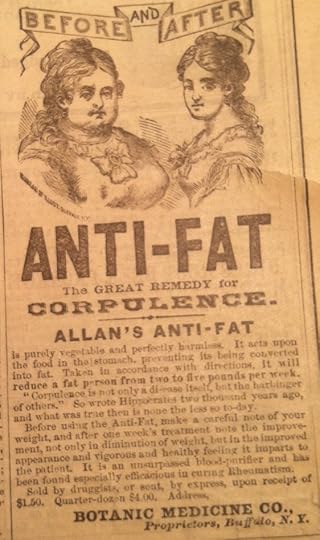 may not look modern but don’t these still appear today? Yet listen to the language and keep in mind that these words are not considered archaic today but…would they be used in an ad? “The Great Remedy for Corpulence: …Corpulence is not only a disease itself, but the harbinger of others….note the improvement, not only in the diminution of weight, but in the improved appearance and vigorous and healthy feeling it imparts…It is an unsurpassed blood-purifier and has been found especially efficacious…”
may not look modern but don’t these still appear today? Yet listen to the language and keep in mind that these words are not considered archaic today but…would they be used in an ad? “The Great Remedy for Corpulence: …Corpulence is not only a disease itself, but the harbinger of others….note the improvement, not only in the diminution of weight, but in the improved appearance and vigorous and healthy feeling it imparts…It is an unsurpassed blood-purifier and has been found especially efficacious…”
When was the last time you heard someone talk about his corpulence problem or speak of something that was efficacious to his health? Writers do often use words that they wouldn’t employ in everyday speech, and the S.A.T. English exams contain words students must learn—only to never practice them again. Why is that? It’s not as if the language is finite, that when new words are invented, old words must die.
So, is there a dumbing down of the English language? Are we losing words?


February 21, 2013
WELCOME TO THE ROMANCING THE WEST BLOG TOUR

Why do we enjoy writing and reading about the West? What is it about cowboys that is just plain irresistible? Over thirty authors and bloggers tackle these and other questions by explaining why we love Romancing the West.
But that’s not all, as you enjoy some awesome blogs and find fantastic books, for every post you comment on with your email address, you will be entered for some amazing prizes.

***PLEASE LEAVE YOUR EMAIL ADDRESS TO QUALIFY***
Grand Prize: A swag pack which includes books (both ebooks and paper), Amazon gift card, custom made butterfly jewelry, book cards, magnets and much more all tucked away in a keepsake box. (Available to US residents only. Winner will be announced on February 26 at 10 PM EST)
THE COWBOY CODE, ALIVE AND WELL
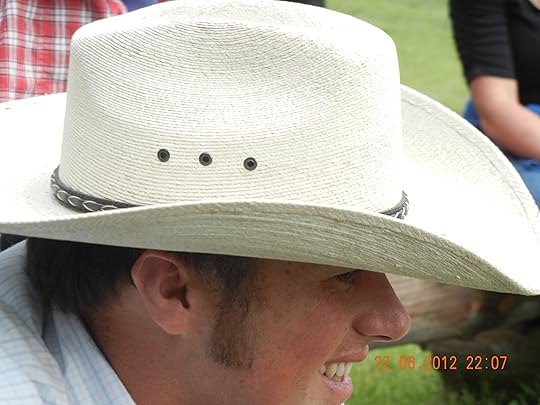 Let’s get past the rippling muscles, the slouch of the Stetson, the jingle of spurs and exactly what those chaps seem to be highlighting. Let’s forget about The Virginian’s mysterious smile, the twinkle in Rowdy Yates’ eyes, or the dimple in Paladin’s chin. I’m talking about the man within here, whatever the heck he looked like, the man you really fell in love with. After all, if these guys had been wimps, two-timing city sidewinders or snakes-in-the-grass, would you have fallen for them?
Let’s get past the rippling muscles, the slouch of the Stetson, the jingle of spurs and exactly what those chaps seem to be highlighting. Let’s forget about The Virginian’s mysterious smile, the twinkle in Rowdy Yates’ eyes, or the dimple in Paladin’s chin. I’m talking about the man within here, whatever the heck he looked like, the man you really fell in love with. After all, if these guys had been wimps, two-timing city sidewinders or snakes-in-the-grass, would you have fallen for them?
Cowboys live by a code. Over the years, the code has taken many forms and been written, so to speak, by many of our heroes. Zane Grey was the first to actually put the creed in print in his 1934 book, Code of the West. While ranchers and cowpunchers would break virtually any territorial, state, or federal law if it suited them, they were actually living by their own code of ethics; after all, they wouldn’t shoot a man in the back, would they? Although there are often variations on the theme, most of the code follows a sort of western version of the Ten Commandments. Think about “Remove your guns before sitting at the dining table” and all that that implies. Or how about “He must always tell the truth?” I’m afraid that when I read “He must always keep himself clean in thought, speech, action and personal habits” I saw the code stretching a bit as well as 99% of western romances flying out the window. It might have worked back in Hopalong Cassidy’s day, but by the time we get to Smith & Jones or Maverick, it’s adios. It is pretty biblical.
Some of the more famous cowboys of television fame had their own codes that paralleled the traditional one. The Lone Ranger believed, “That God put the firewood there, but every man must gather and light it himself.” Roy Rogers had a ‘prayer’ that included the words, “…when trails are steep and passes high, 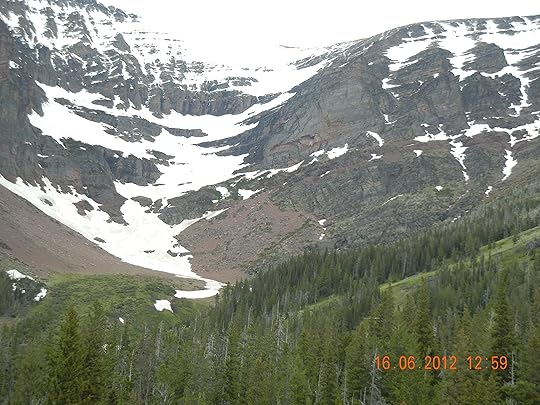 let me ride it straight the whole way through.” On the website Old West Legends http://www.legendsofamerica.com/we-codewest.html there is a long list of what constituted the code of the west. It includes such advice as, “Cuss all you want, but only around men, horses and cattle” and “Always drink your whiskey with your gun hand to show your friendly intentions.” More recently, in the book Cowboy Ethics: What Wall Street Can Learn from the Code of the West by James P. Owen, we have “Ride for the Brand” and “Talk less and say more.”
let me ride it straight the whole way through.” On the website Old West Legends http://www.legendsofamerica.com/we-codewest.html there is a long list of what constituted the code of the west. It includes such advice as, “Cuss all you want, but only around men, horses and cattle” and “Always drink your whiskey with your gun hand to show your friendly intentions.” More recently, in the book Cowboy Ethics: What Wall Street Can Learn from the Code of the West by James P. Owen, we have “Ride for the Brand” and “Talk less and say more.”
So think about the man this code projects. 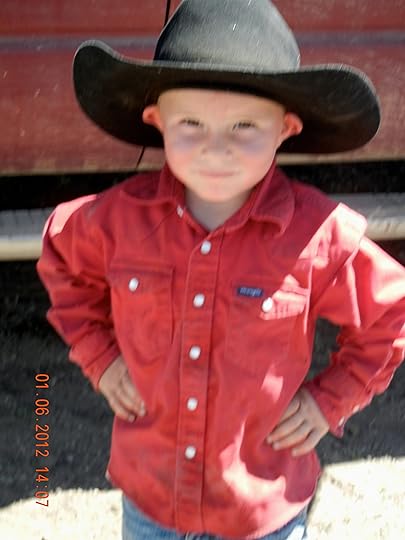 Strong, trustworthy, well-mannered, respectful of women yet a fighter and a doer, a defender while still being excitingly hard-living and a little bit of rough. Is the code alive and well? Yup, sure is—and living in Wyoming. Back in 2010, Wyoming Governor Dave Freudenthal passed a state code based on the tenets put out in the Owen book. Although the bill entails no penalties or fines, as a gesture it is an admirable doctrine to have in this day and age.
Strong, trustworthy, well-mannered, respectful of women yet a fighter and a doer, a defender while still being excitingly hard-living and a little bit of rough. Is the code alive and well? Yup, sure is—and living in Wyoming. Back in 2010, Wyoming Governor Dave Freudenthal passed a state code based on the tenets put out in the Owen book. Although the bill entails no penalties or fines, as a gesture it is an admirable doctrine to have in this day and age.
And, of course, if you package all that with the mysterious smile and the slouched Stetson, well…what could be better than that?
***********************************************************************
I am pleased to offer one ebook of Loveland to a reader who answers the following question (answer to be found on this website) and leaves their response as a comment. All readers who leave a comment with their email address will be entered, as noted above, for the grand draw.
For more exciting blogs on this Blog Hop, go to http://cowboycharm.blogspot.com/2012/... or simply click the button in my side column.
Ques.: In Loveland, Lady Alex and Jesse argue because (a) she has kissed another man (b) she stole his gun (c) he took her horse.


February 2, 2013
HOOKS, FIRST LINES, AND STINKERS
No, not me personally, but hopefully if you’re a reader or writer, have been to school, have any education in American Lit. whatsoever, you may recognize that line. And no, it’s not, as my daughter suggested, from the Bible. How about: “It is a truth universally acknowledged, that a single man in possession of a good fortune must be in want of a wife.“ Is that the romance writer’s motto? Or one of the most famous lines in English literature? How about this one: “Happy families are all alike; every unhappy family is unhappy in its own way.” That might be a bit tougher since it’s a translation and, depending on which edition of the book you have—if you have piled through its 1100 pages—it may not be exactly as you remember it. So let’s try “It was the best of times, it was the worst of times, it was the age of wisdom, it was the age of foolishness, it was the epoch of belief, it was the epoch of incredulity, it was the season of Light, it was the season of Darkness, it was the spring of hope, it was the winter of despair, we had everything before us, we had nothing before us, we were all going direct to Heaven, we were all going direct the other way…”
Whoa now, as we say in the western historical business. That’s not only the opening paragraph, that is all one dang sentence and I haven’t even quoted it in full. If I submitted that to my editor today I’d probably get back a request to break it into smaller sentences. So what makes a good opening line?  Is it the short and snappy, definitely memorable “Call me Ishmael?” Could it be the positive, highly quotable statements, offered in the middle two? Or the compelling resonance of the last? As writers we’re told to have a fresh, new voice and, to me, voice is what makes a good hook or great first line. Here is an opening of an equally famous book by the author of the last quotation, but I’ll bet my bottom dollar you have no idea from which of his many famous novels this comes: “Among other public buildings in a certain town, which for many reasons it will be prudent to refrain from mentioning, and to which I will assign no fictitious name, there is one anciently common to most towns….” Now, thanks to the wonders of Google, I can’t make this into a quiz, but my own reaction is that, that opening is not as individual, not as specific to the story, as the previous ones. While it may not exactly be a “stinker,” it lacks the distinctive voice necessary to make a great first line. It also doesn’t set the tone of the book, give you any idea where exactly it is taking place, who the characters may be, or any sense of what, exactly, is to come. Look at, “Last night I dreamt I went to Manderley again.” That one, brief sentence gives you a whole world of information; furthermore, it pulls you straight into the story. And, more than anything, it has a very certain voice. It seems to me that, nowadays, writers are so keen to get straight into the action as their editors tell them, that the memorable first line has been left by the wayside.
Is it the short and snappy, definitely memorable “Call me Ishmael?” Could it be the positive, highly quotable statements, offered in the middle two? Or the compelling resonance of the last? As writers we’re told to have a fresh, new voice and, to me, voice is what makes a good hook or great first line. Here is an opening of an equally famous book by the author of the last quotation, but I’ll bet my bottom dollar you have no idea from which of his many famous novels this comes: “Among other public buildings in a certain town, which for many reasons it will be prudent to refrain from mentioning, and to which I will assign no fictitious name, there is one anciently common to most towns….” Now, thanks to the wonders of Google, I can’t make this into a quiz, but my own reaction is that, that opening is not as individual, not as specific to the story, as the previous ones. While it may not exactly be a “stinker,” it lacks the distinctive voice necessary to make a great first line. It also doesn’t set the tone of the book, give you any idea where exactly it is taking place, who the characters may be, or any sense of what, exactly, is to come. Look at, “Last night I dreamt I went to Manderley again.” That one, brief sentence gives you a whole world of information; furthermore, it pulls you straight into the story. And, more than anything, it has a very certain voice. It seems to me that, nowadays, writers are so keen to get straight into the action as their editors tell them, that the memorable first line has been left by the wayside.
After writing all of the above, my nephew pointed out to me that there are two websites of famous first lines: http://americanbookreview.org/100BestLines.asp AND http://www.stylist.co.uk/life/the-best-100-opening-lines-from-books I promise you I had not checked either of these sites nor any other prior to deciding which first lines to include here, so I was absolutely delighted to find that my five good lines scored on both sites. What surprised me, however, was that nearly half—43 to be exact, in the case of the first site—were post-1960. While I had certainly read a good number of the modern novels, I hadn’t recalled their first lines at all. So, was that because the older lines were drummed into me as part of education or because they were just better?
You might write to me and say that we remember the lines from classics  and perhaps the truth is that we don’t write like authors of the 19th and early 20th Centuries. When I asked my daughter (double degree cum laude in Music and Latin American Studies; hence, not an English major!) if she recalled any first lines, all she could come up with was “Twas the night before Christmas…” So I’d like to know how many of you out there recognized without help any or all of the six first lines I’ve included above. If you’re a writer, I’d like to hear how much you sweat over your first line to make it a hook into the story? And I’d love to hear YOUR favorite first lines, particularly if they are more recent than these. On or about Feb. 21st, I’ll give away one copy of Loveland (opening line: “The clamor started at Ten o’clock when all the men were in their bunks.”) to someone who either ‘stumps’ me with a classic first line, i.e. pre-1960, I feel I should recognize, or enthralls me with a memorable post-1960 first line. And I promise not to cheat!
and perhaps the truth is that we don’t write like authors of the 19th and early 20th Centuries. When I asked my daughter (double degree cum laude in Music and Latin American Studies; hence, not an English major!) if she recalled any first lines, all she could come up with was “Twas the night before Christmas…” So I’d like to know how many of you out there recognized without help any or all of the six first lines I’ve included above. If you’re a writer, I’d like to hear how much you sweat over your first line to make it a hook into the story? And I’d love to hear YOUR favorite first lines, particularly if they are more recent than these. On or about Feb. 21st, I’ll give away one copy of Loveland (opening line: “The clamor started at Ten o’clock when all the men were in their bunks.”) to someone who either ‘stumps’ me with a classic first line, i.e. pre-1960, I feel I should recognize, or enthralls me with a memorable post-1960 first line. And I promise not to cheat!
Good luck!


December 28, 2012
THE ORPHAN TRAIN by Eunice Boeve
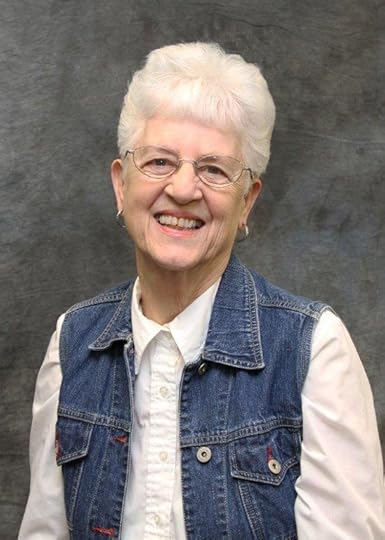 Author Eunice Boeve writes award-winning historical fiction for both adults and children. In her home state of Kansas, she has also had two serials of historical fiction for children featured in syndicated newspapers for a program called Newspapers in Education. The program, which targets schools, also provides guides for classroom use.
Author Eunice Boeve writes award-winning historical fiction for both adults and children. In her home state of Kansas, she has also had two serials of historical fiction for children featured in syndicated newspapers for a program called Newspapers in Education. The program, which targets schools, also provides guides for classroom use.
Eunice’s first story for the NIE in 2011 was a time travel story which she eventually lengthened and published as a book titled Echoes of Kansas Past. Last year’s serial, set during WWII about a boy whose father was fighting in Germany, was titled Wishing You Home. It went on to win third place in the Midwest Circulations Management Association contest for the NIE program, while the Kansas Press Association has underwritten the cost of making it available to schools for the 2012-13 academic year.
In January, 2013, Eunice’s third serial, A Home for Us, will appear for the NIE program. The story concerns a boy on the orphan train, a theme she also used in one chapter of Echoes of Kansas Past where her two young protagonists are transported back in time to become riders on the Orphan Train. However, Eunice is not alone in using this part of America’s past. Put ‘Orphan Train’ into the Amazon search engine and you will find no less than twenty pages of books, videos and even music dealing with this aspect of American history. I was therefore exceedingly pleased that Eunice agreed to write about this for my blog this month.
***********************************************************************
America was and still is a shining beacon of hope and many have flocked to her shores. The first immigrants usually settled in the eastern cities with New York receiving the lion’s share, and especially so in the years between 1840 and 1869, when the city was inundated, creating a scarcity of jobs and housing. That, in turn, caused the breakdown of many families, and those who found themselves unable to provide for their children brought them to orphanages or abandoned them to the streets. Life was less certain in those days too, and the death of a parent or parents left still other children homeless.
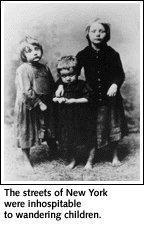 One estimate gives the number of homeless children roaming the streets by the 1850s at 30,000. In 1854, Charles Loring Brace, the founder and director of the Children’s Aid Society, came up with the idea of taking those children from orphanages and city streets, and sending them out on trains to farm families in America’s heartland. Farm tables, it was said, always had room for one more.
One estimate gives the number of homeless children roaming the streets by the 1850s at 30,000. In 1854, Charles Loring Brace, the founder and director of the Children’s Aid Society, came up with the idea of taking those children from orphanages and city streets, and sending them out on trains to farm families in America’s heartland. Farm tables, it was said, always had room for one more.
Dubbed the Orphan Trains, those trains made scheduled stops,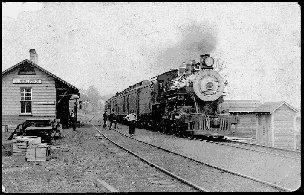 sending out advanced notices in fliers and in newspapers, and those who could take a child or two gathered to await their arrival. One such flyer read: Homes for Children Wanted. A Company of Homeless Children from the East Will Arrive at McPherson (Kansas), Friday, September 15. The notice goes on to say that
sending out advanced notices in fliers and in newspapers, and those who could take a child or two gathered to await their arrival. One such flyer read: Homes for Children Wanted. A Company of Homeless Children from the East Will Arrive at McPherson (Kansas), Friday, September 15. The notice goes on to say that 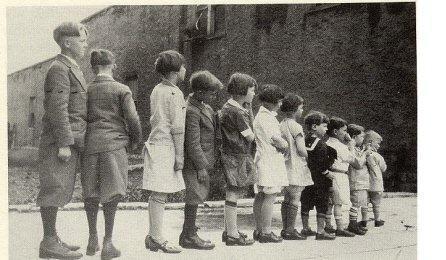 these are children of both sexes, of various ages, and all well disciplined coming as they do from various orphanages. It also stated that persons taking a child/children must be recommended by the local committee. (Their names (6 of them) are listed at the bottom of the flyer.) Furthermore, the children are to be raised as family, attending school and church and properly clothed until they are eighteen years old, and that Protestant children are to be placed in Protestant homes and Catholic children in Catholic homes. Come and see the children and hear the address by the (attending ) agents, the flyer reads. Distribution will take place at the Opera House at 10:00 a.m. and 2:00 p.m.
these are children of both sexes, of various ages, and all well disciplined coming as they do from various orphanages. It also stated that persons taking a child/children must be recommended by the local committee. (Their names (6 of them) are listed at the bottom of the flyer.) Furthermore, the children are to be raised as family, attending school and church and properly clothed until they are eighteen years old, and that Protestant children are to be placed in Protestant homes and Catholic children in Catholic homes. Come and see the children and hear the address by the (attending ) agents, the flyer reads. Distribution will take place at the Opera House at 10:00 a.m. and 2:00 p.m.
Among the children who rode the Orphan Trains was Bill Ferris. He and his brother were to be sent on the train to the Midwest, but Bill got sick and the brother went alone to where, Bill did not know. The next year, Bill was among the next batch of orphans sent out on the train. In Nebraska, he stepped down off the train and waiting for him was his brother and the couple who had taken him the year before. Bill and his brother grew up in a happy, secure home.
Others weren’t so fortunate. One young girl got off a train in Kansas and lived a nightmare of abuse. Another child, “Hoot” Gibson of Missouri, lived in a Brooklyn orphanage until in 1923 at age 9, he was sent out on an Orphan Train and taken by a couple who had lost a son in WWI. They gave him the dead son’s name. Later, placed with another family, he was given another name. When he joined the army during WWII, he took back his original name.
Some children were taken as servants or hired hands. Some prospective “parents,” especially those interested in acquiring field hands and other laborers, checked limbs and teeth as if buying a horse. A few would-be-parents, caught up in the excitement of getting a child, thought better of it in the light of day with the actual child standing before them and backed out.
Most agents tried to keep siblings together in the same home, but often that didn’t work out. Two brothers rode the train to Texas. There they were taken into a home and both were happy until the couple decided they only wanted the little boy and so the bigger boy was sent to another home. Soon, though, that couple decided they didn’t want him either and so he was moved on again. This time, he was fortunate to be taken in by a couple with the capacity to love and understand a young boy and in time their home became his home.
Some orphanages sent people out the following year to check up on the children and if abuse was suspected or blatantly obvious, the children were removed, often to another family in the same or nearby communities.
Usually the children were accepted in the community and in the schools, 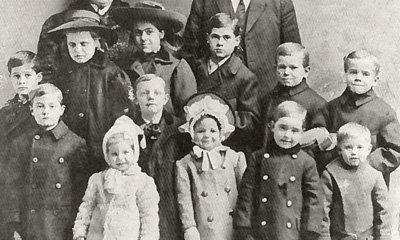 but some were bullied or ignored. Even some adults admonished their children to keep away from those “foreigners.” The children who were taunted and shunned, overworked, and ill-treated carried with them a kind of stigma and even as adults many would not acknowledge that they rode those trains. It is estimated that about 200,000 children were placed in this manner. The program ended in 1929.
but some were bullied or ignored. Even some adults admonished their children to keep away from those “foreigners.” The children who were taunted and shunned, overworked, and ill-treated carried with them a kind of stigma and even as adults many would not acknowledge that they rode those trains. It is estimated that about 200,000 children were placed in this manner. The program ended in 1929.
Concordia, Kansas houses the Orphan Train National Museum and Research Center that documents this part of history and keeps records for those looking for family connections. Some books available on this subject are: The Orphan Trains: Placing out in America by Marilyn Holt, The Orphan Trains by Annette Fry, and Searching for a Home by Martha Nelson Vogt and Christina Vogt For other information contact Amanda Wahlmeier, curator of the museum, at Concordia. 785-243-4471.
***********************************************************************
ALL PHOTOS COURTESY OF THE NATIONAL ORPHAN TRAIN COMPLEX, CONCORDIA, KS; Amanda Wahlmeier, curator
For more information on Eunice and her books, please go to her website at http://www.euniceboeve.net or reach her by email at roneun@ruraltel.net
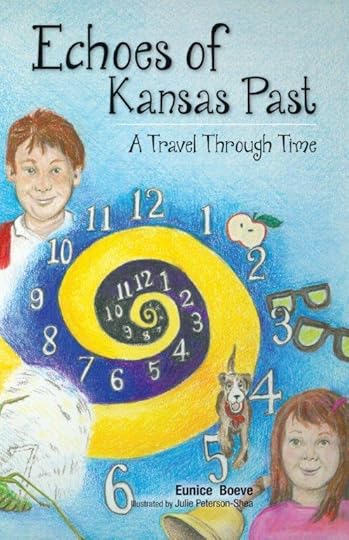 Echoes of Kansas Past: In this illustrated chapter book, fourth grade twins, Jack and Mollie, accidentally activate their parents’ time machine. Their first adventure in time and space is as Kanza Indians in 1620. From there they move on to meet others who in some way have shaped Kansas history, including a ghost, and a very famous horse. Available from Amazon, Barnes and Noble, and the publisher at http://rowepublishingdesign.com/Echoe...
Echoes of Kansas Past: In this illustrated chapter book, fourth grade twins, Jack and Mollie, accidentally activate their parents’ time machine. Their first adventure in time and space is as Kanza Indians in 1620. From there they move on to meet others who in some way have shaped Kansas history, including a ghost, and a very famous horse. Available from Amazon, Barnes and Noble, and the publisher at http://rowepublishingdesign.com/Echoe...
Eunice’s latest adult novel is Crossed Trails:
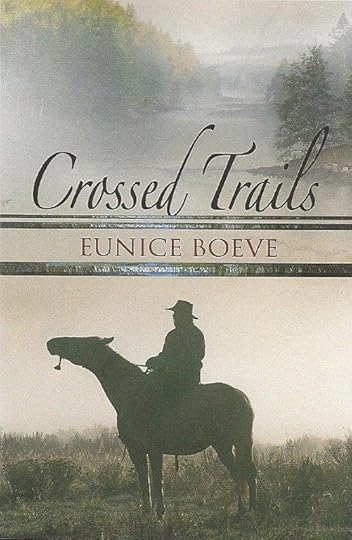 The summer of 1877, Joshua Ryder seeking a life of solitude crosses the trail of a Nez Perce woman with a newborn baby and ends up in Virigina City, Montana. There he becomes the provider of an unlikely family and falls under the shadow of the hangman’s noose.
The summer of 1877, Joshua Ryder seeking a life of solitude crosses the trail of a Nez Perce woman with a newborn baby and ends up in Virigina City, Montana. There he becomes the provider of an unlikely family and falls under the shadow of the hangman’s noose.
Crossed Trails is available at http://www.whiskeycreekpress.com/stor... and Amazon and Barnes and Noble
My sincere thanks to Eunice Boeve for being my guest and sharing her knowledge of this fascinating part of America’s past.



